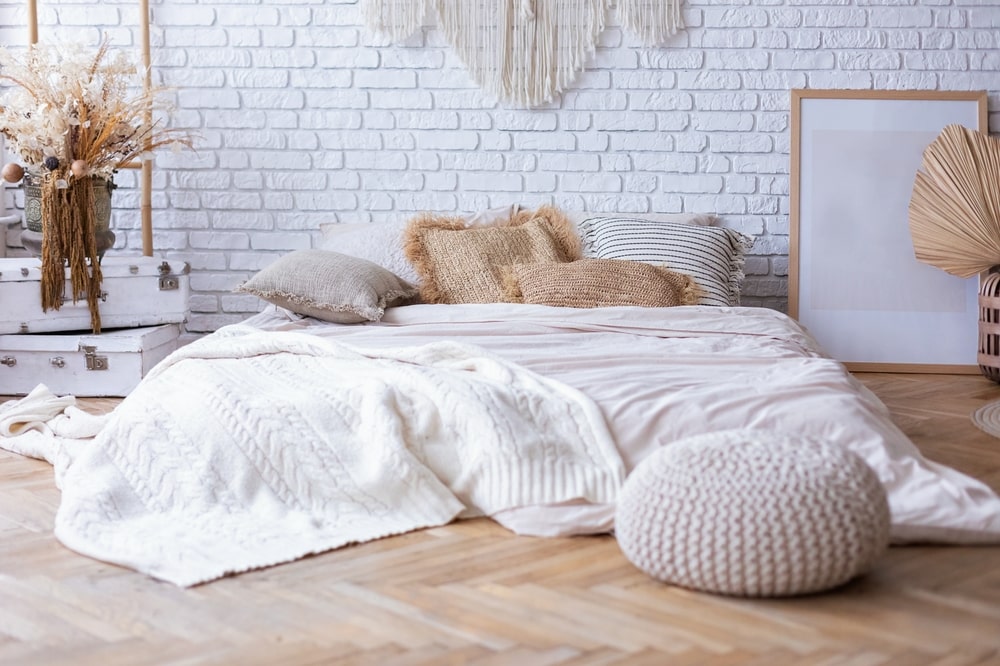
Can You Sleep on a Mattress on the Floor?
Sleeping with your mattress directly on the floor might sound like either a minimalist dream or just a temporary setup when you’re between bed frames. Either way, it's a common question: Can you sleep on a mattress on the floor? And more importantly, should you?
People end up sleeping on the floor for all kinds of reasons. It could be because you’re moving into a new place, trying to improve back pain, or simply going for that sleek, low-profile look. Plus, let’s face it, skipping the bed frame is a great way to save money if you’re moving into a new place. But while it can seem like a simple, no-fuss solution, it’s not without its downsides.
In this post, we’ll break down the pros and cons of sleeping with your mattress on the floor. We'll talk about hygiene, airflow, bugs, back pain, mattress types, and how to do it safely if you’re set on skipping the frame.
Why Do People Put Mattresses on the Floor?
There are actually a bunch of reasons people choose to sleep with their mattress on the floor, and not all of them are budget-related.
-
Aesthetic appeal: The minimalist, floor-bed vibe has become a bit of a trend, especially in smaller or modern-style homes. It can make a room feel more spacious and simple.
-
Cost savings: Skipping the frame could potentially save you hundreds.
-
Back-to-basics comfort: Some believe that sleeping closer to the ground or on a firmer surface can help with posture or back pain.
-
Cultural tradition: In many countries, sleeping close to or on the floor is the norm, such as futons in Japan or roll-out mats in other parts of Asia.
-
Practicality: If you’re moving, living somewhere short-term, or setting up a guest room, putting the mattress directly on the floor might be the easiest option.
In short, there are a number of legit reasons people go frameless. But before you roll your mattress out, it’s worth looking at the full picture.
Pros of Sleeping with a Mattress on the Floor
There are a couple of genuine perks to placing your mattress on the floor:
-
It’s affordable: No frame or foundation means you’re directly saving money upfront.
-
Firm support: The floor is as solid as it gets, which can feel more supportive to some people especially if you don’t like your bed to be soft and squishy.
-
Cooler sleeping environment: Since hot air rises, being lower to the ground may keep you cooler in warmer weather, making it easier to sleep at night.
-
Space-saving design: It’s great for small rooms or creating a clean, modern look. This is especially true if you can move the mattress away when it’s not being used.
That said, it’s not all sunshine and savings. There are some definite drawbacks to consider before committing to the floor life.
Cons of Sleeping with a Mattress on the Floor
While a mattress on the floor can be a short-term fix or design choice, it comes with a few not-so-great trade-offs that you need to keep in mind:
-
Dust and allergens: You’re closer to everything on the floor, and that includes pet hair, dust mites, pollen, and more.
-
Lack of ventilation: Mattresses need to breathe. No airflow underneath can trap moisture and lead to mold or mildew.
-
Pest exposure: No one wants to wake up next to a spider or ant.
-
Harder to get in and out of bed: This can be a deal-breaker for anyone with mobility issues.
-
Possible warranty voiding: Many mattress brands require the use of a proper foundation, so skipping it might actually void your warranty.
The bottom line is that the convenience and simplicity might not be worth it for everyone.
Is It Good for Your Back?
This is a tricky question because it really depends on your body and your mattress. Some people swear that sleeping with their mattress on the floor helps relieve lower back pain, especially if they were previously on a sagging or too-soft bed. The idea is that a firmer surface can promote better spinal alignment.
But the flip side is that too much firmness (like a floor with no cushion) can actually create pressure points and make things worse, especially for side sleepers or people with chronic back pain.
Your mattress type matters a lot here. If it’s designed to work with a frame and has softer foam layers, putting it on a hard floor might mess with its intended support system and you might not get all of the benefits. That means your hips, shoulders, or back could suffer.
If you're experiencing pain, it’s best to talk to a medical professional before switching up your sleep setup. A firmer feel might help, but only if it still provides the support and cushioning your body needs.
Allergies, Hygiene and Airflow
Here’s the not-so-glamorous truth: your floor is a magnet for dust, dander, hair, pollen, and even mold spores, especially if you have carpet. When your mattress sits directly on the floor, there’s nothing between you and all those allergens. And if you have pets, you’re probably sharing your sleeping space with a lot more than you think.
Beyond allergens, there’s also the issue of moisture. Mattresses are designed to breathe, and airflow underneath helps regulate temperature and keep things dry. Without that circulation, trapped moisture (from sweat, humidity, or a damp floor) can lead to mold and mildew buildup inside your mattress. This is especially problematic for foam ones. Want to keep things cleaner? If you're set on sleeping on the floor, try:
- Using a waterproof or breathable mattress protector
- Cleaning your floor frequently
- Airing out your mattress by propping it up against the wall every few days
It won’t be perfect, but it can help minimize the risks.
Bugs and Other Unwelcome Guests
No one wants to think about it, but if you’re sleeping on the floor, you’re closer to the insects that might be wandering around your home at night. Spiders, ants, bed bugs, roaches, silverfish–you name it. The lower your mattress is, the easier it is for these little visitors to climb in for a cuddle. To avoid this, make sure to:
- Keep your room clean and free of crumbs or food
- Seal any cracks or gaps around doors and windows
- Consider natural repellents like lavender or peppermint oil
It’s also smart to check your mattress regularly for any signs of bugs because once they’re in, it’s difficult to get them out.
What Type of Mattress Works Best on the Floor?
Not all mattresses are floor-friendly. If you're going frameless, hybrid and innerspring mattresses tend to hold up better. Their coil layers allow for more internal airflow, which helps prevent moisture buildup. They’re also more structurally sound, so they won't sag as easily without a foundation.
Foam mattresses, especially memory foam, are trickier. They’re more prone to mold and mildew because they retain heat and moisture, and they often rely on a solid or slatted base for proper support. Placing them directly on the floor can shorten their lifespan and mess with your spinal alignment. If you must use a foam mattress on the floor:
- Make sure the floor is clean and dry
- Lift it up regularly to let it breathe
- Rotate it to avoid uneven wear
And always check your mattress manufacturer’s guidelines as some brands explicitly say not to put their mattresses on the floor or else the warranty will be voided.
Give Your Mattress a Little Lift
While sleeping on the floor might work in the short term, most mattresses are designed to perform best with a supportive base. A good foundation can help extend your mattress’s lifespan, improve airflow, and make getting in and out of bed a whole lot easier. Even a simple collapsible platform can offer big benefits without taking up much space.
Looking for something with a little more comfort and flexibility? Adjustable power bases like the Reverie EZ Fold let you raise your head to ease pressure with zero gravity, and it can even reduce snoring. Some models are whisper-quiet, app-compatible, and fold easily for transport, making them both practical and high-tech.
Ultimately, the right foundation supports more than just your mattress. If you’re on the fence about ditching the floor, it might be time to give your bed a proper home.
Is Sleeping on the Floor Right for You?
Sleeping with your mattress on the floor isn’t necessarily wrong, but it’s definitely not ideal for everyone. If you’re after a minimalist aesthetic or trying to save space or money, it can work as long as you’re taking steps to keep your setup clean, dry, and well-ventilated.
On the other hand, if you deal with allergies, mobility issues, or have a high-maintenance mattress, you’re probably better off sticking with a traditional bed frame or platform.
So to conclude, it’s important to listen to your body, take care of your mattress, and read the fine print. A good night’s sleep is worth a little extra effort whether it’s a few inches off the ground or not.
